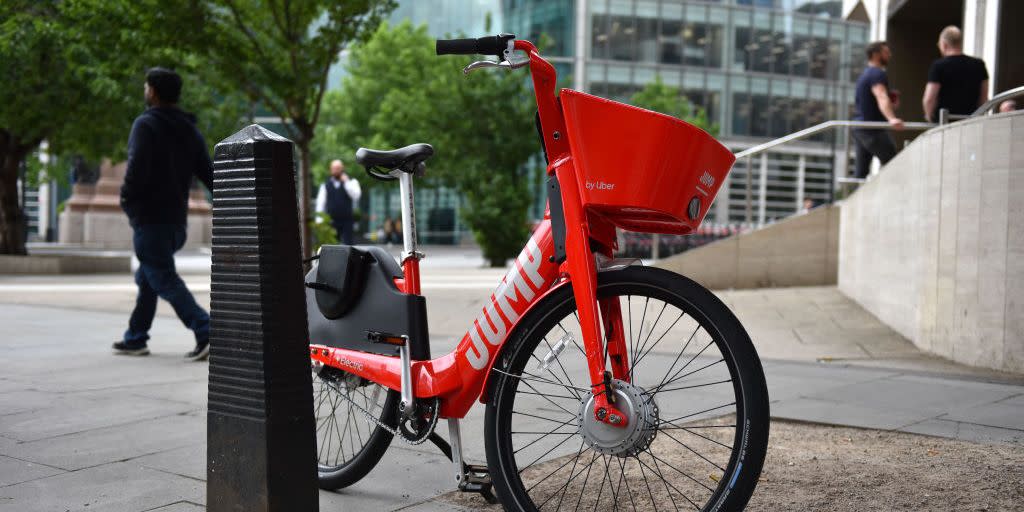Thousands of JUMP E-Bikes Are Trashed, Prompting Criticism

Uber is drawing widespread outrage from bike advocates and others for disposing of thousands of JUMP e-bikes and e-scooters after the company transferred the bike and scooter business to Lime earlier this month.
On May 22 and May 26, Twitter user Cris Moffitt tweeted out photos and videos of JUMP e-bikes being destroyed at a scrap yard in North Carolina, courtesy of a friend who works at the scrap yard. The tweets quickly went viral, and many are criticizing Uber for this wasteful move, especially as the country is experiencing a major bike shortage brought on by more people biking during the coronavirus pandemic.
‼️RT to MAKE A CHANGE‼️
Hey @JUMPbyUber, why is this happening? TEN semi loads of good bikes🚲trashed⁉️ Let's collaborate on a non-profit to repaint & repurpose these. Give kids transportation to their first jobs👧👦@Casey want to help?🙏 pic.twitter.com/N8Uv82tr1B— Cris Moffitt (@CrisMoffitt) May 22, 2020
[Want to fly up hills? Climb! gives you the workouts and mental strategies to conquer your nearest peak.]
Moffitt later estimated that there were 30 semi-truck loads’ worth of e-bikes at the scrap yard.
Meanwhile, a recent blog post from the Bike Share Museum says there are about 20,000 scrapped e-bikes, based on information shared by JUMP employees. Uber confirmed with NBC News that it was disposing of “thousands” of e-bikes, but wouldn’t say exactly how many.
More keep rolling in and getting trashed.🚲🗑️ Probably THIRTY semi loads🚚🚚🚚 or more so far ... #SenselessWaste #BikesForKids 👧👦 @UberJump pic.twitter.com/ee3NmCP7If
— Cris Moffitt (@CrisMoffitt) May 27, 2020
Though JUMP is now operated by Lime, the massive bike disposal appears to be on Uber’s end of business. Lime confirmed to Bicycle Retailer that it had received “tens of thousands” of the former JUMP e-bikes, and that it’s already put some back into use in Denver.
“We have not recycled any of the JUMP e-bikes in our fleet and are committed to scaling and operating them during this critical time. Once the transaction officially closes, we plan to work with Uber to find sustainable ways to donate and re-use any remaining e-bikes in their inventory,” a Lime spokesperson told Bicycle Retailer.
However, that doesn’t address why so many bikes were sent to the scrap yard. Many believe the e-bikes should have been donated to those in need instead.
“Heavy as they are, these could be transportation for the many who have been brought to financial ruin during COVID-19,” the Bike Share Museum’s blog post read. But it looks as though that was something Uber did take into consideration.
“We explored donating the remaining, older-model bikes, but given many significant issues—including maintenance, liability, safety concerns, and a lack of consumer-grade charging equipment—we decided the best approach was to responsibly recycle them,” Uber told NBC News.
Concerns about turning over such bikes to private owners, even with proper oversight and precaution, are still pretty valid. It can be dangerous to charge an e-bike battery without the correct charger. And though e-bike fires are relatively rare, they can happen even with all the right equipment—as Lyft and Lime have seen in the past. Plus, the e-bikes were not designed with private ownership in mind.
The Bike Share Museum suggested simply removing the batteries in order to safely donate the e-bikes, but few might be willing to ride a 75-pound e-bike without a battery.
It’s possible that Uber did its societal diligence and fully looked into how to best refurbish the e-bikes for donation or for Lime’s use. Whatever the case, the disturbing image of thousands of bikes being turned into scrap metal raises important questions about the potential wastefulness of bike shares, given the turnover of the companies that operate them and the frequent obsolescence of older bike models.
You Might Also Like

